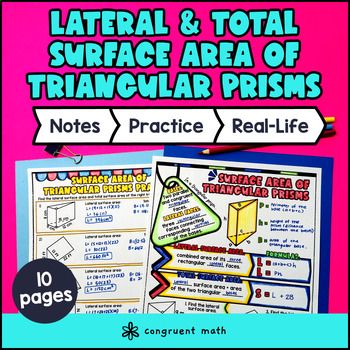Want more ideas and freebies?
Get my free resource library with digital & print activities—plus tips over email.
Join for Free Resources →
$4.25
Ever wondered how to teach lateral and total surface area of triangular prisms in an engaging way to your 7th grade students? In this lesson plan, students will learn about lateral surface area, total surface area of triangular prisms and its real-life applications. Through artistic, interactive guided notes, check for understanding, a doodle & color by number activity, and a maze worksheet, students will gain a comprehensive understanding of calculating surface area. The lesson concludes with a real-life example that explores how surface area is used in practical situations.

$4.25
After this lesson, students will be able to:
Before this lesson, students should be familiar with:
As a hook, ask students why calculating the lateral surface area and total surface area of triangular prisms is important in real life. Refer to the last page of the guided notes as well as the FAQs below for ideas.
Use the first page of the guided notes to introduce the concept of lateral surface area. Explain that the lateral surface area of a prism is the sum of the areas of all its lateral faces. Emphasize that the lateral faces are the faces that are not the bases of the prism. Walk through the key points of calculating the lateral surface area, including identifying the height and base of the triangle, and using the formula A = (1/2) * base * height.
Continue using the first page of the guided notes to introduce the concept and formulas of lateral surface area vs. total surface area. Explain that the total surface area of a prism is the sum of the areas of all its faces, including the bases and the lateral faces. Walk through the key points of calculating the total surface area, including identifying the height and base of the triangle, and using the formula A = (1/2) * base * height for the lateral faces, and the formula A = base * height for the bases. Refer to the FAQ below for a walk through on this, as well as ideas on how to respond to common student questions.
Use the second page of the guided notes to model some examples with your students. Then, allow them to practice a few problems on their own or in groups. Based on student responses, reteach concepts that students need extra help with. If your class has a wide range of proficiency levels, you can pull out students for reteaching, and have more advanced students begin work on the practice exercises.
Have students practice calculating the lateral and total surface area of triangular prisms using the Practice Worksheet activity (pg. 2 of guided notes). Then have them work on the maze activity (pg. 3 of guided notes). Walk around the classroom to answer any questions and provide assistance as needed.
Fast finishers can dive into the color by number activity (pg. 4 of guided notes) for extra practice. You can also assign it as homework for the remainder of the class.
Use the last page of the guided notes to bring the class back together, and introduce the concept of a real-life application of calculating the surface area of triangular prisms. Explain that understanding how to calculate surface area is not only a mathematical concept but also has practical uses in the real world.
In real-life, the concept of surface area is used in various fields such as architecture, engineering, and designing. One practical application is in the construction industry, where architects and engineers need to calculate the surface area of triangular prisms to determine the amount of material needed to build structures such as roofs, tents, and awnings.
For example, when designing a tent, knowing the surface area of the triangular prism-shaped tent will help in estimating the amount of fabric required to cover it. Architects also use surface area calculations when designing roofs with triangular facets. By calculating the surface area of each triangular face of the roof, they can determine the amount of shingles or roofing materials needed.
Refer to the FAQ section in the resource (or last page of the guided notes) for more ideas on how to further explore and teach the real-life applications of calculating surface area.
If you’re looking for digital practice for calculating lateral and total surface area of triangular prisms, try my Pixel Art activities in Google Sheets. Every answer is automatically checked, and correct answers unlock parts of a mystery picture. It’s incredibly fun, and a powerful tool for differentiation.
Here are a few activities to explore:
A fun way to wrap this lesson with your students is with one of my real-life math projects. They enable students to see the application of the math in an engaging, extended project:
The lateral surface area of a triangular prism is the sum of the areas of all the lateral faces excluding the triangular bases.
To calculate the lateral surface area of a triangular prism, follow these steps:
The total surface area of a triangular prism is the sum of the areas of all the surfaces, including the bases and lateral faces.
To find the total surface area of a triangular prism, follow these steps:
Calculating the surface area of triangular prisms is useful in various real-life situations, such as:
Here are a few strategies to engage your students when teaching about surface area of triangular prisms:
Learning about surface area of triangular prisms is important because:
Some common mistakes students make when calculating surface area of triangular prisms include:
Get my free resource library with digital & print activities—plus tips over email.
Join for Free Resources →